The Murie Science and Learning Center (MSLC) funds numerous outreach projects through the Science Education Microgrant program. The microgrants help MSLC partner parks pay for science education outreach projects. Funding for the microgrants is provided by Alaska Geographic.
Copper River Stewardship Program
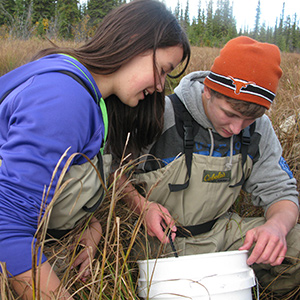
Project Coordinators:
- Robin Mayo, Wrangell Institute for Science and Environment
- Glenn Hart, Wrangell St. Elias National Park
- Kate Morse, Copper River Watershed Project
- Marnie Graham, Bureau of Land Management--Glennallen
The Copper River Stewardship Program (CRSP) is a place-based learning expedition designed to engage local high school students in a hands-on exploration of the Copper River Watershed. In 2015, students spent 11 days exploring the watershed and participating in research and conservation projects.
One of the highlights of the trip was participating in a multi-day rafting trip of the Copper River, along the border of Wrangell St. Elias National Park and Preserve. During the trip, students made observational studies of the ecosystem and contribute to the area's scientific community. The students also participated in Salmon Blitz, a citizen science project that aims to identify salmon habitat for inclusion in the Alaska Department of Fish and Game's Anadromous Warers Catalog.
From the Field to the Lab: Finishing What we Started
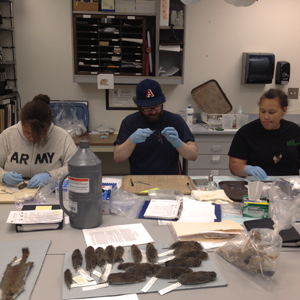
NPS Photo / Melanie Flamme
Project Coordinators:
- Melanie Flamme, Yukon-Charley Rivers National Preserve and Gates of the Arctic National Park and Preserve
- Link Olson, Curator of Mammals, University of Alaska Museum Department of Mammology
From trapping voles in the field to curating them in the laboratory, a team of 19 high-school and college students from Fairbanks completed the valuable collection of over 800 small mammal specimens. Specimens were collected by the Central Alaska Inventory and Monitoring Network’s long-term small mammals live-trapping program in Denali over the last 23 years and represent a wealth of information useful for further ecological, genetic and climate change studies.
Through these experiences, the students gained resume-building experiences and a deeper understanding of natural resource stewardship and relevancy of natural areas in support a goal to foster education and scientific scholarship in youth. This fall, in partnership with the Alaska Teen Media Institute, the students made a video of their experiences during the project.
This project was completed in partnership with the University of Alaska Fairbanks-Department of Mammalogy laboratory (UAM), Effie Kokrine Early College Charter School, Murie Science and Learning Center and Alaska Geographic.
Arctic Science Camp for Inupiaq Eskimo Students
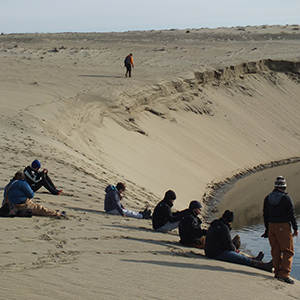
Project Coordinators:
- Linda Jeschke, Project Leader
- Tyler Teuscher, Education Specialist
- Melanie Flamme, Project Biologist
- Zach Martin, Noatak Biology Teacher
- Dan Shelden, Fly Fishing Instructor
- Dan Stevenson, Aviation Manager
During the summer of 2015, Inupiaq students in the native village of Noatak, Alaska had an opportunity to participate in challenging science projects at the Great Kobuk Sand Dunes wilderness in Kobuk Valley National Park (KOVA). The park is relatively close to Noatak but very few of the students have been to this dune ecosystem because it is 200 road less miles away. This science camp helped introduce high school students to their local park by showing them how to camp in a remote wilderness area and experience, first-hand, many skills required of a field biologist. Students participated in 7 different science activities led by one NPS biologist, 2 rangers, their own science teacher, and a fly fishing expert. These activities enable students to learn about conservation of their subsistence resources and imagine a path to becoming field biologists in their national parks.
Nome Community Archaeology Expedition
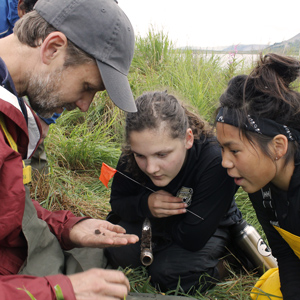
Project Coordinators:
- Jeff Raisic, Gates of the Arctic National Park and Preserve, Yukon-Charley Rivers National Preserve
- Elizabeth Oliver, Alaska Geographic
This July, eleven high school students from across Alaska converged at Salmon Lake, near Nome and close to Bering Land Bridge National Preserve to learn about the history and culture of western Alaska, to consider careers in conservation and scientific fields, to make friends, and have fun. During the week-long camp students gained experience in archaeological survey and GPS mapping, recorded oral histories with local elders, launched a field trip to the historic Pilgrim Hot Springs, and studied museum curation at the Carrie M. McLain Museum.
“One artifact I’ll never forget is the tool that catches fish called “naquq.” I think this tool took some time to perfect, and hopefully in my future as an archaeologist I’ll find many other versions. Being here has really inspired me to do research of my own.”
– Daphne Stein, Kotzebue
Thanks to our partners, Alaska Geographic, Bering Straits Native Corporation, Kawerak Inc., and the Carrie M. McLain Memorial Museum, who supported the project and made such broad participation from rural Alaska possible. Stay tuned for next year’s installment of the Nome Community Archaeology Expedition.
North for Science!
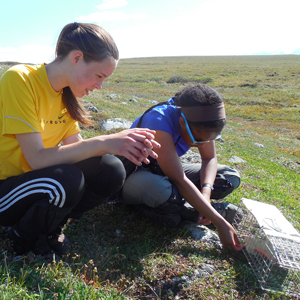
Project Coordinators:
- Maria Berger, Fairbanks Alaska Public Lands Information Center
- Carol Scott, Fairbanks North Star Borough School District
- David Tomeo, Alaska Geographic
For the second year in a row, the North for Science! expedition was able to engage middle school-aged youth in arctic field research and resource management activities during an eight-day, immersive outdoor experience across several federal public lands in Alaska.
During the program students traveled up the Dalton Highway from Fairbanks to the University of Alaska's Toolik Field Station. Along the way, they camped at Bureau of Land Management campgrounds and were engaged in a variety of acitivities including collecting data about snowshoe hares, learning about bear behavior, participating in a songbird count, and meeting with numerous researchers. In this program's second year it continues to give youth the opportunity to learn, grow, and explore our spectacular northern public lands in an immersive and fun environment.
Tags
- bering land bridge national preserve
- gates of the arctic national park & preserve
- noatak national preserve
- wrangell - st elias national park & preserve
- yukon - charley rivers national preserve
- murie science and learning center
- gates of the arctic
- yukon-charley rivers national preserve
- noatak national preserve
- wrangell st. elias national park
- microgrant
- microgrants
- bering land bridge national preserve
Last updated: January 10, 2017
